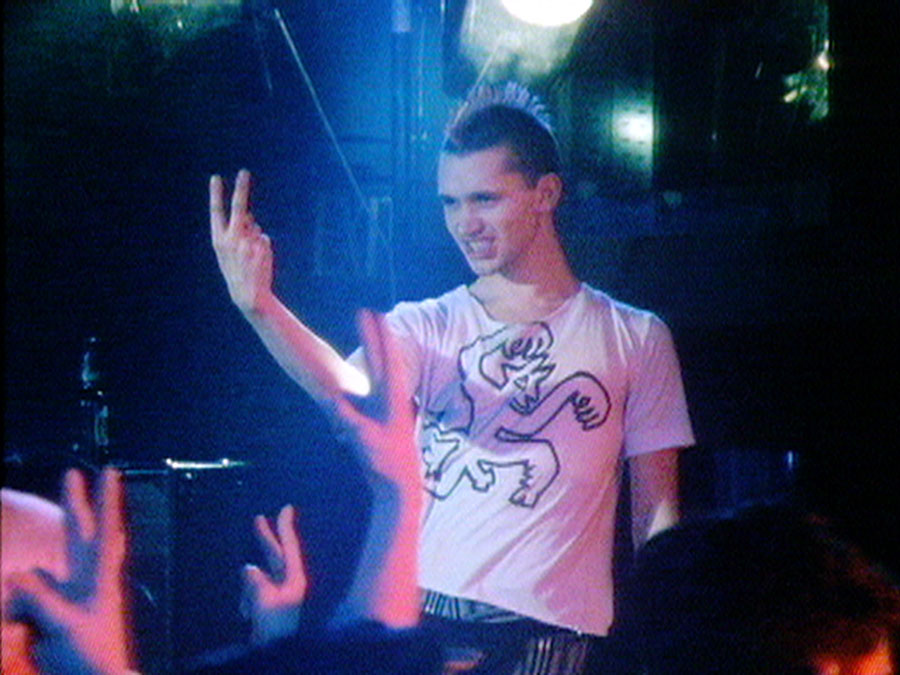When in Doubt, Go Out: Celebrating Jeffrey Hinton
Sean Burns profiles the filmmaker and DJ, a friend to generations of artists, designers and club-goers
Sean Burns profiles the filmmaker and DJ, a friend to generations of artists, designers and club-goers

‘Everyone always wants to talk about the fucking 1980s,’ quipped filmmaker and nightlife doyen Jeffrey Hinton, pointing a camp, neon-blue portable lamp meant to treat seasonal affective disorder at his face. We were in his council flat in London’s Camden this past December, surrounded by a hoard of gay treasure, including hundreds of dusty hard drives and tapes containing footage of underground nightlife, dance, parties, performance, drag, fashion – spanning decades and both sides of the Atlantic. ‘I vaguely know where everything is,’ he said. I asked if he had any reels featuring the legendary peacocking fashion designers Jane Kahn and Patti Bell. Et voilà! – after five minutes, he’d found a film unseen since 1985. ‘I can give you some one-liners if you’d like?!’ he joked.

‘Archive’ would suggest an indexical taxonomy of stuff, which isn’t the case here. The map is in Hinton’s head and the thousands of hours of film cover wide-ranging art and clubbing scenes. The cramped, colourfully lit apartment also houses an extensive collection of vinyl from every imaginable genre, vintage clothes and art books. Hinton is, in his own words, ‘a hoarder’. I almost don’t know where to begin with his multitudinous life. You name it, he’s been there. He was in New York with William S. Burroughs in the late 1970s, in London’s now-famous Warren Street squat through the 1980s. When I first went to his place some years ago, I picked up Bop It! – a children’s toy – off a hip-height pile of QX Magazine back issues. ‘Oh, that thing – Lee McQueen gave me that,’ Hinton said, pouring his second cup of tea. ‘I have a matchbook with “GG’s Barnum Room” on it,’ he continued, recalling the 1970s New York nightspot known for its spectacular trapeze above the dancefloor. He has gone out to bars and clubs every night for 40 years. For many queers, he is a supportive, warm figure who cuts through the commercial bullshit of contemporary life.

Hinton left his west London home at the age of 13 and ‘forgot to go back’. We joked that his mother is still waiting for him. His older brother, Stephen, introduced him to the nightlife world of The Dilly: the notorious rent scene around Piccadilly Circus. The London of the early 1970s contrasts starkly with the city today: It was bomb damaged, bankrupt and choked with cigarette smoke. Hinton affectionately remembers the care extended to him, as a teenager, by the queens and activists who surrounded his brother, a compassionate attitude that he accords to the people around him.

His footage shows fragments of experience, which he mashes together using a chaotic over-laying technique to make scratch films. One of my favourite sequences is of the ‘filthy’ drag queen Divine, squeezed into a skin-tight silver tube dress, barking her 1984 hit ‘You Think You’re a Man’ onstage at London’s Heaven. Hinton attended the club’s opening night in December 1979, and he still DJs there now. ‘I could have gone down the coke-y route and earned a lot of money,’ he mused, reflecting on his nocturnal career in sound-tracking some of London’s best-known parties, including Taboo, Fruit Machine, Queer Nation and Cha Cha. While some of his contemporaries mythologize their place in cultural history, Hinton does not historicize – he has never disengaged.

His archive is also a way of keeping people close, even when they’re gone. In 2017, we screened his homage to Leigh Bowery and the life they shared, Scratch Bowery (2015), in my basement. In the film, familiar faces appear disarmed, even casual. It’s remarkable how people react differently to the camera today. We’re acutely aware of our self-image, scared almost of stepping out of line. Hinton’s films depict queer resistance, joy and struggle, all shot on the ground. They are packed full of individuals who are no longer alive. Drag queens, dancers, models, performers, many of whom died tragically from complications related to AIDS.

After Camden Council turfed everyone out of Warren Street, Hinton, Princess Julia, John Maybury and Stephen Jones decamped to Mornington Crescent. It’s unimaginable now that squatters could be offered permanent, central housing in lots considered ‘undesirable for occupancy’. Hinton worked closely with Michael Clark in the 1980s, including producing music for Charles Atlas’s masterpiece on the hot ballet maverick, Hail the New Puritan (1986). I asked him about Clark’s forthcoming exhibition at the Barbican in London, to which he replied: ‘I hope they’re able to re-create the vibrant energy of the moment, otherwise there’s no point doing it.’ The sharing of resources and ideas was essential to the creative community that existed around Warren Street in the 1980s. A good example of this collaborative ethos was the catwalk shows of David Holah and Stevie Stewart’s influential fashion label, BodyMap.

Now and again, Hinton crops up on panel discussions, often crashing through a young academic’s illusions about the past. He advocates doing things. If you want to throw a party, throw a party. If you’re going to produce a film or fashion line, do so now. ‘I’ve always pushed against the construct of what something is,’ he said. ‘I’ve never followed any of “the rules”,’ which is, of course, infinitely appealing in a sometimes-cautious climate. His films offer an insight into hidden nightlife worlds with complicated and ongoing histories of queer visibility and liberation. For generations of artists, designers and club-goers, Hinton continues to be a source of inspiration as well as a confidant, friend and constant.
Projections from Jeffrey Hinton’s film archive will accompany ‘Opening Night: More Than Just a Pretty Face – Alt Drag Revolution’ at ICA, London, on 10 January 2019.
Main image: Jeffrey Hinton, Dragarge – In High Energy Split Screen, 2016. Courtesy: © the artist























